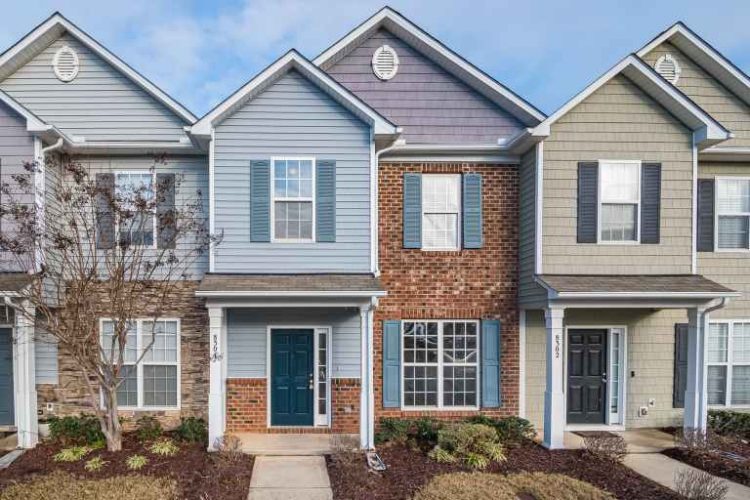October 13, 2021
Problems with Pipestems
The value of various features of subdivision development can be evaluated by whether they makes people happy or leads to acrimony. The value of property is inextricably intertwined with its use potential. Generally, where there are few disputes among the owners, this may indicate that the developer did something right in creating the community.
August 12, 2021
Condominium Bylaw Liability Waivers and Claims for Water Damage
Many condominium unit owners experience water damage from leaks in pipes, walls or other common elements managed by the unit owners’ association. This happens in both new condominiums with construction defects and older associations with growing maintenance problems. Condominium associations have the privilege of controlling and the responsibility for maintaining the common elements. Unit owners must pay assessments to maintain the common elements, master insurance premiums, and other common expenses. The declaration and bylaws define the rights and responsibilities of the association and the unit owners with respect to the units, common elements and limited common elements. Although the unit owners hold title to the common elements as co-owners, the statutes and bylaws do not give unit owners rights to treat the common elements as their own. While the bylaws require the association to maintain the common elements, often the same instrument (or an amendment) includes a waiver relieving the association of liability for damages arising from a leak from a common element to a unit. Associations and unit owners often disagree over the scope of the liability waiver and the obligation to maintain. This is complicated by the failure of the association to properly fund its accounts through assessments. While bylaw liability waivers may seem fair to the other unit owners voting for them or the boards relying on them, not all unit owners are affected in by a defect in the common elements in the same way. Efforts to keep costs down for the majority has the tendency to put particular units at higher risk later. Each condominium unit has a different location within the development. Just because something keeps costs down for most people, doesn’t make it intrinsically fair or wise. The District of Columbia Court of Appeals considered some of these issues in a May 2021 decision. Jennifer Baker owned a unit in the Chrissy Condominium on F Street, Southeast. Her unit began experiencing a severe water leak in May 2018 that forced Baker to offer her tenants free rent. Later the tenants left because of the water problem. The association ignored her requests for assistance. Ms. Baker retained a structural engineer who identified grading and waterproofing problems with the rear foundation wall that needed correction. This would cost in the range of $14,000.00 to $20,500.00. Ms. Baker passed this information on to the management company who said that they advised the association to complete the repairs to the foundation wall which was a common element. The association decided not to conduct the repairs because it would empty their reserve account. Ms. Baker could not sell, rent out, or use the condo unit herself because of the water infiltration problem. She could not unilaterally resolve the situation because the wall is a common element within the association. Baker sued the condominium association on a variety of claims related to the water infiltration problem, including damages for the diminution of the monetary value of her unit, pain and suffering, attorney’s fees and a request for an injunction that would require the association to complete the repairs. The D.C. Superior Court dismissed all of the claims. For reasons which are not clear, Baker did not appeal the dismissal of her claims for injunctive relief, damage to property values, and pain and suffering. With regard to the other claims, the association argued successfully in the Superior Court that the liability waiver in the condominium bylaws provided the association with a complete defense. That section, Provision 7.11, has language similar to that found in other condominium bylaws in D.C. and Virginia:The Association shall not be liable for any failure of water supply or other services to be obtained by the Association or paid for as a Common Expense or for injury or damage to person or property caused by the elements or resulting from electricity, water, snow or ice which may leak or flow from any portion of the Common Elements or from any wire, pipe, drain, conduit, appliance or equipment.Baker’s attorney argued that the association ignored other language in the Bylaws that expressly required them to maintain the common element wall. Baker pointed out that the association’s reading of the Bylaws, if correct, would leave Baker without any remedy for the failure to maintain this particular common element. Baker pointed out that there are other damages that arise out these actions beyond the damage to property resulting from water leaking from the common elements into her unit. Baker seems to be arguing for this liability waiver to be construed strictly or narrowly as an exception to a generally recognized duty of a condominium association to maintain its common elements. The Superior Court agreed with the association, ruling that the liability waiver language was not limited by the other provisions requiring the association to maintain the wall. The trial court and the association’s arguments relied heavily upon a 1998 D.C. appellate decision, D’Ambrosio v. Colonnade Council of Unit Owners. In that earlier case, the unit owner sued the association after a pipe burst and caused damage to the unit. The limited liability bylaw in Chrissy was functionally the same as the Colonnade Council’s instruments. The 2021 Baker decision, like the earlier D’Ambrosio case concluded that such liability waiver language does not allow the unit owner to recover for damage to the unit attributable to the deficiency with the common element. However, that’s not all that Baker sought in her lawsuit. Baker argued that the association’s persistent and continuing failure to repair the wall after timely notice resulted in extensive financial and emotional damage. This includes the diminished value of the condominium unit and the loss of rental income. Baker argued that these damages resulted from the failure to maintain and were not limited by the waiver language. In Baker, unlike some other cases, it was clear that the association was responsible for maintaining the thing at issue. The Court of Appeals rejected the association’s arguments that the consequential economic injuries alleged by Baker were not semantic reclassifications of damages from the water intrusion itself. The Court agreed with Baker that such damages could be traced to the association’s failure to correct the wall after it had been called to their attention. The Court found that the association’s obligation in the bylaws to maintain the wall was meaningless unless there was some way that breach of it could give rise to a cause of action with a legal remedy. The Court of Appeals concluded that the Superior Court incorrectly short-circuited this case before trial. The case is presently back in the Superior Court awaiting a new pretrial schedule. In 1989, the Supreme Court of Virginia considered analogous issues related to similar language in the instruments of the Ocean Owners’ Council in Virginia Beach. The Supreme Court held in the case brought by Arthur Nido that the liability waiver language was not void as against public policy, and effectively limited damages resulting from the events listed in the provision. However, like the D.C. Court of Appeals, the Supreme Court of Virginia also found that this kind of waiver did not completely absolve the association of all responsibility. The other language in the bylaws requiring the association to maintain the common element was enforceable. “This limitation does not leave the owners a right without a remedy. The owners retain the right to sue the Council for damages in instances where the damage arises from circumstances other than those enumerated.” The Superior Court’s dismissal of the claim for injunctive relief was not appealed. An injunction is an order by the court for the defendant to specifically do something or refrain from doing something. The liability waiver provisions limited the association’s responsibility for damages caused by the leaking itself, but that doesn’t prohibit injunctive relief, because as the court of appeals recognized, the provisions in the bylaws requiring the wall to be maintained must have some legal meaning. The duty to maintain the common areas and the exclusive right to manage them is what makes a condominium what it is, as opposed to some other kind of shared property arrangement. This is the justification for all of the debt collection tools that the D.C. condominium act gives the unit owners association. The District of Columbia’s laws regarding condominium unit foreclosure for the failure to pay assessments is much more board-friendly than the laws in Virginia and some other states. It makes no sense for Ms. Baker to lose her unit if she fails to pay her assessments, but there is no consequence if the association fails to uphold their end of the “bargain” reflected in the recorded bylaws. This is why unit owners and their attorneys ought not to give up if the association insists that the liability waiver provisions completely absolve them of all responsibility in the event that the failure to maintain causes a problem for a unit owner. Legal Authority: Baker v. Chrissy Condominium Association, 251 A.3d 301 (D.C. May 27, 2021) Nido v. Ocean Owners Council, 237 Va. 664 (1989) Media: The photo at the top of this blog post is something that I took with my cell phone camera of the back of the D.C. Court of Appeals during construction in June 2018.
July 16, 2021
Can HOA Boards be Overridden through Group Action by Owners?
Many owners want to know what options they have to overturn bad board decisions without using litigation and when waiting to the annual director election isn’t an option. This raises the issue of what legally binding results “community organizing” can accomplish when the board majority appears to have already made up their mind.
July 13, 2021
How a Lawyer Can Help Owners Protect their Rights in HOAs and Condominiums
According to trade association data, approximately 1,980,000 Virginians live in 778,000 homes in more than 8,7000 community associations (HOAs, condominiums, etc.). In the District of Columbia, approximately 111,000 residents live in 48,000 homes located in more than 1,300, community associations.
June 25, 2021
Can a Board of Directors Make Decisions for the HOA by Unanimous Emails?
Condominium and HOA leaders usually expect the owners and tenants to do what they tell them to do, and often struggle to back down when their authority is questioned. At the same time, boards and committees like to make decisions that affect others without being monitored or disclosing what was done.
June 11, 2021
Worlds are Colliding! When Attorneys Sit on HOA Boards
Before Jaime Harrison ran for U.S. Senate or became chair of the Democratic National Committee, he was a director on the board of a condominium in Alexandria, Virginia while I was an owner-occupant. We had annual elections for board positions. Sometimes there was an election, other times we left without voting because there was not quorum.
May 20, 2021
Making Property Decisions as the Region Reopens
On May 14, 2021, Virginia Governor Ralph Northam lifted the indoor mask mandate in light of updated CDC guidance. Governor Northam also declared that the indoor capacity restrictions and distancing restrictions will ease, effective May 28, 2021. The District of Columbia and neighboring states are also lifting restrictions, effective around the Memorial Day weekend.
May 13, 2021
Do Attorney General Lawsuits Actually Help Consumers?
Whenever a legal dispute seems intractable, many people want an agency or official to bring the power of the government to bear on their problem with their adversary. Aggrieved persons often try to exhaust such possibilities before retaining their own attorney. Regulatory enforcement through federal, state or local resources seems more attractive than expending one’s own.
April 28, 2021
Have We Already Agreed to Settle or Merely Agreed to Later Agree?
People usually think of a “litigation settlement” as written, agreed terms signed by the parties. However, parties can become legally bound to oral or electronic settlement terms before the parties get to a formal writing or court order. Generally speaking, a contract to settle a lawsuit or other dispute does not require a signed writing to be binding. When settlement discussions culminate late at night or on the courthouse steps, the parties may be confused as to whether the exchange constitutes a binding agreement or a mere step towards a future agreement. When the parties agree upon a set of settlement terms, the legal work does not end there. Best practices call for the attorneys to properly reduce the agreement to a written agreement, so that its terms may be implemented and avoid the acrimony over what had been agreed to.
There have been recent judicial opinions about what constitutes a settlement agreement. In the 2019 personal injury case Cully v. Smith, the Circuit Court of Fairfax County found that although the parties had not signed a written instrument, they had entered into a binding agreement in the form of email exchanges between their lawyers regarding settlement of a personal injury case by payment of $610,000.00 in exchange for a dismissal. In Cully v. Smith, the insurance defense lawyer representing Todd Smith sent the plaintiff David Cully’s counsel an email stating, “Our last and final offer is $610,000. If not accepted before the settlement deadline of May 7 at noon, that offer is withdrawn and no further settlement will be considered.” Cully’s lawyer responded, “Mr. Cully accepted your below offer of $610,000 in full and final settlement of this case.” Next, the insurance companies sent $610,000.00 to the defense lawyers, who then told the plaintiff they would pay the money if provided with a written release of Smith, Smith’s employer and the insurance companies. Counsel to the Plaintiff Cully responded that the settlement only had two terms: (1) payment of $610,000 and (2) settlement of the civil suit. The insurance defense lawyers argued that the execution of a written release was customary in settlement of personal injury claims and ought to be included in understanding what the parties meant, or alternatively that the agreement was only “in principle” and ought not to be enforced by the court as to only those two terms because it wasn’t fully formed. The wording used in negotiations determines whether it is mere words discussing ideas about settlement or if the exchange constitutes an enforceable contract itself. So, if there is a preliminary settlement agreement, how does one know if it is binding or unenforceable? Some states such as Maryland (in the 2020 case 4900 Park Heights Ave. LLC v. Cromwell Retail 1, LLC) recognize four categories of “settlements in principle” as identified in the treatise, Corbin on Contracts:
- At one extreme, the parties may say specifically that they intend not to be bound until the formal writing is executed, or one of the parties has announced to the other such an intention.
- Next, there are cases in which they clearly point out one or more specific matters on which they must yet agree before negotiations are concluded.
- There are many cases in which the parties express definite agreement on all necessary terms, and say nothing as to other relevant matters that are not essential, but that other people often include in similar contracts.
- At the opposite extreme are cases like those of the third class, with the addition that the parties expressly state that they intend their present expressions to be a binding agreement or contract; such an express statement should be conclusive on the question of their “intention.”
According to this analysis, when an agreement to settle falls into the first or second categories, it is not yet enforceable, and the parties must finalize the terms before it becomes binding. For agreements that fall within the third or fourth categories, they do not require any additional formalization to be legally enforceable. Even if there is already a binding contract, the parties can agree to amend or restate it for whatever reason. While Judge David Oblon does not cite the Maryland case law outlining these categories, the settlement emails in the Cully v. Smith case would appear to fall within the third category. A settlement agreement is a “contract,” formed by “consideration” and “mutual assent.” Consideration is what is bargained for, i.e., a price, property, benefit to the party making the promise or the detriment to whom the promise is made. A promise that does not include anything bargained for in exchange isn’t a contract. Mutual assent is determined by the reasonable meaning of the parties’ expressions actually communicated to the other party. We typically think of this in terms of “offer and acceptance.” When one party communicates something that comes across as a clear, definite take-it-or-leave-it proposition, and that is accepted, then that creates a binding contract. An exchange of emails between lawyers (or the parties themselves) regarding settlement can result in an enforceable contract between the parties (without the necessity of later reducing that to a formal looking written agreement). Not all email exchanges accomplish this, because the wording of the exchanged communications matters. Generally speaking, attorneys have authority to bind their clients in matters dealing with the litigation, such as signing consent orders or submitting responses that may be deemed a party admission. However, in settlement negotiations, attorneys do not have implied authority – there must be express authority from the client to bind him under contract law. However, no authorization letter from the client is necessary. The client’s express authorization of the attorney may be inferred from the words or conduct of the attorney.
In the Cully v. Smith case, there was no apparent issue with the lawyers’ authority to negotiate the settlement. The defense attorney’s email was deemed a contractual “offer” because of how clear and unequivocal it was. His words manifested an intention for the recipient to have the power to accept it, because of the take-it-or-leave-it qualities. Courts are loathe to set aside formed contracts (even if oral or unofficial looking). There is a judicial presumption in favor of finding the contract not to be so indefinite or uncertain as to set it aside. The lawyer’s email included a specific dollar amount. The court observed that the term “settlement” unambiguously refers to ending of a suit or dispute by a compromise including specific compensation. By contrast, a “release” is an immediate relinquishment or discharge of the right of action. Both a release and a settlement preclude further suit regarding the resolved claim. Documents are often styled “Settlement and Release Agreement” or “Settlement Agreement and Release” because the insurers want the release and the claimant views the compensation as essential. Fairfax County Circuit Court ruled that the email exchange was binding and that the plaintiff was not required to provide the written release as an additional requirement to get the $610,000.00. Insurance companies are accustomed to getting things resolved the way they desire because they are the ones paying the money. Its common for plaintiffs, once they get to a certain point in the case and the promise of money is made, to be willing to sign what they are asked to sign when they are okay with the price. It’s not uncommon for the parties and lawyers to agree upon certain terms and then the lawyer for one side prepares a written agreement that fails to properly reflect the agreed upon terms, adds additional language that changes the overall meaning of the settlement or other bait-and-switch tactics. Sometimes the parties agree to terms, and then all the terms have to be re-negotiated in the context of reducing the agreement to a written instrument to be signed.
In his opinion, Judge Oblon discussed a 2001 settlement dispute that went to the Supreme Court of Virginia, Alexakis v. Mallios. In that case, the parties informed the judge that the case had been settled and recited the terms into the court reporter’s transcript at the hearing, indicating that they had resolved all claims. Included in the settlement was sale of a parcel of real estate on documentation identical to those used in a prior transaction. In that case, the Supreme Court observed that the purchaser’s undisclosed interpretation could not defeat the unambiguous, express terms of the settlement. If one side later had concerns arising after the recitation of the terms into the record, they came too late. The Alexakis case illustrates why lawyers should be on their toes should their opponent try to recite settlement terms in open court before a judge so that they are recorded in the court reporter’s transcript as an official evidence of contract, because the terms may not be recited correctly. Also, counsel should be cautious about employing the “read the terms into the record” trick because their opponent may later hold them to precisely those terms, despite the absence of desired items. Once the terms are recited into the court reporter transcript and assented to, either side can move the court to reduce the terms to a written order that can subsequently enforced legally if breached. In the Cromwell Retail 1, LLC opinion, the Maryland Court of Special Appeals partially reversed the judgment because the trial court entered an order that did not accurately reflect the terms of the settlement made by the parties.
In April 2021, the Supreme Court of Virginia decided Bolton v McKinney, reflecting a development of the law in Virginia with respect to litigation settlements. Generally speaking, prevailing litigants in Virginia (and almost all other states) may not, with very limited exception, recover their attorney’s fees against their opponent unless there is a statute or contract that provides for an award of attorney’s fees. This is called the “American Rule.” The issue of attorney’s fees arises in the context of settlement agreements because having to pay a lawyer to defend a lawsuit brought after there has been a settlement and release is contrary to the whole notion of settling in the first place. Attorneys routinely put prevailing party attorneys’ fees provisions into their settlement agreements. Bolton and McKinney made a “Settlement Agreement and Global Mutual Release of Claims.” Later, McKinney sued Bolton three times relating to the same issues in the settlement, causing Bolton to incur lawyer bills in excess of $80,000.00. The Settlement Agreement was silent on the issue of attorney fee awards. The issue of Bolton’s attorney’s fees came up, and the circuit court declined to award them, because they weren’t provided for in the contract or any applicable legislation. The Supreme Court decided that the “American Rule” does not apply in breach of covenants not to sue cases, because the expenditure of attorney time in a direct or consequential result of the breach of the covenant not to sue. The Court observed that without a fee-shifting effect, the covenant not to sue could not be vindicated, because there would not be any practical consequence if a party can repeatedly breach the covenant not to sue and not bear financial consequences. The holding of Bolton v. McKinney is important to understand in cases like Cully v. Smith or Alexakis v. Mallios where there is a covenant not to sue that is agreed upon in emails or in a recorded conversation, and later there is a subsequent suit and the issue of attorneys’ fees arises.
These things may make settlement agreements sound mysterious or scary but they really aren’t. The meaning of words used in settlement negotiations matters. An experienced attorney can help the client when the opponent tries to walk back on terms already agreed. Parties should carefully consider what is being said or not said when engaged in settlement discussions that become exhaustingly protracted or are sprung on you unexpectedly.
Legal Authority:
Cully v. Smith, 102 Va. Cir. 293 (Fairfax Co. Jul. 9, 2019)
Alexakis v. Mallios, 261 Va. 425 (2001)
Bolton v. McKinney, 2021 Va. Lexis 24 (Supr. Ct. Va. Apr. 1, 2021)
4900 Park Heights Ave. LLC v. Cromwell Retail 1, LLC, 246 Md. App. 1 (2020)
April 8, 2021
Resolving HOA Enforcement Through Voluntary Compliance
When a homeowner receives a notice of violation from their HOA or condominium, they must decide if they are going to fight it, comply or file an architectural application to receive formal approval. There are many instances when the homeowner can and ought to keep the installed improvement. However, there are other situations in which it makes more sense to comply with the HOA’s request or to otherwise adjust things to address the violation. Also, HOAs frequently send out notices in error or the homeowner receives them after the violation was cured. However, the story does not always end with the voluntary compliance by the landowner. Often the covenant enforcement process will continue with additional letters or HOA hearings despite the correction. There may be pending litigation. The HOA or neighbor instigating such in or out of court complaints may have some sort of axe to grind and wants to continue the legal action vindictively. This blog post addresses the legal aspects of covenant enforcement when the accused owner has cured or abandoned the complained of structure or activity. I am not saying that the owner’s default response to a HOA letter ought to be to just obey it.
Fairfax County Circuit Court considered such questions in a 2004 decision. Rose Hall HOA filed a complaint with the court seeking an injunction and attorney’s fees against an owner, Charles H. Jelinek, whose architectural application for a black ornamental fence was denied but they installed it anyway. While suit was pending, the Jenlineks removed the complained of fence. The letter opinion of Judge Kathleen MacKay doesn’t say whether they removed the fence because it was not allowed by the language of the covenants or if the owners took it down not because they were in the wrong but to simply avoid continued legal action. The HOA filed discovery requests in an effort to continue fighting in court. The Jelineks filed a motion to have the suit dismissed on the grounds that it was now moot because the fence was removed. The HOA wanted to continue the suit, not because they thought that the fence would be put back up, but only because they wanted to get an award of attorney’s fees as the prevailing party. Did the HOA “prevail” in the litigation because the owner removed the complained of fence after suit was filed? In this suit, the HOA did not seek any damages. The court found that now that the fence is gone, the HOA cannot prevail because an injunction order cannot be entered because the grounds for the injunction is no longer at issue. Where the defendants action sought to be enjoined has been abandoned, the whole grounds for equitable relief no longer exists, and the matter ought to be dismissed. Unlike suits for money damages, cases like injunctions or declaratory judgments are in what’s called “equity jurisdiction,” which requires an actual controversy to be presently existing. This doctrine is commonly referred to as a question of “mootness” (when the alleged violation has ceased) or “ripeness” (when the offense hasn’t happened yet). The court found the case moot and dismissed it in its entirely.
In some cases, the factual context for the mootness question is less clear-cut than a complaint about a fence that has been completely removed. Sometimes suits for injunctions are more about conduct or how improvements or objects on the property are used rather than their mere existence. In cases involve flooding or erosion, the water infiltration may not occur every day, and in fact may be irregular depending upon the weather or how the defendant has configured downspouts that day, or other conditions. In some cases, an injunction may be granted even if the complained of conduct only occurred once. Some cases raises a question as to whether the complained of improvement actually violates a legal obligation owed by the landowner to the association under the governing instruments or if the HOA is overstepping its bounds. The owner may decide to reconfigure the fence, drain or other structure or vegetation to conform to the instruments (and not necessary what the manager is ordering them to do). The opponents may want to pursue the case more aggressively, arguing that the corrective activity somehow functioned as an admission that the HOA or neighbor was right and the owner was wrong. However, that may misconstrue the defendant’s actions or intentions. Also, angry people sometimes want their opponent to cease doing things related things that have always been legal as a kind of punishment.
For reasons such as these, when HOA or neighbor disputes escalate to litigation, sometimes “giving in” on certain points can be a powerful legal defense strategy, but one that must be properly navigated to resolve the dispute while adequately defending the owner’s rights.
Case Discussed:
Rose Hall HOA, Inc. v. Jelinek, et al., 66 Va. Cir. 172 (Fairfax Co. Oct. 28, 2004)(MacKay, J.).
Note that the picture associated with this blog post is a stock image and does not depict anything discussed in this article.
February 17, 2021
Role of Survey Plats in Resolving Property Disputes
When landowners purchase real estate, they get the opportunity to obtain a land survey or to save a few hundred dollars by avoiding it. During the home buying process, purchasers’ financial situation is usually stretched to their utmost limit. The owner may not understand the value of paying $200-$600 for a survey plat when there is no known issue that would be addressed by the boundary survey. But checking out “known unknowns” is an important part of buying real estate. Relinquishing the opportunity to obtain a survey before purchase is often at the buyer’s peril.
A home inspection may reveal defects in the construction or maintenance of the home that could cost hundreds or thousands of dollars to remedy. The title examination process conducted by the settlement company reveals the legal description of the property and any title problems that may exist. However, there are basic questions about what the buyer actually obtains for the purchase price that can only be answered by a land survey that reflects the findings of a title search and proper field work. For example, fences, walls, shrubs and driveways may give misleading impressions of the boundaries. Such impressions may be at odds with the dimensions of the lot as shown in the subdivision plat.
A lot may be encumbered by a pipestem driveway easement serving a lot behind the property and the location of the paved portions, trees and fences around the easement may encroach into the easement or the driveway veers off the easement. Legal disputes frequently arise between the owners of pipestem lots and the properties across which their driveways run. Purchasers are often attracted to lots adjacent to HOA common areas or public parks because many people would rather see a wooded area, pond, or creek behind one’s house, instead of other people’s backyards. However, whether publicly or privately owned, park-like areas are attractive to joggers and hikers in the neighborhood who might find it easier to cut across someone’s lawn rather than exit the woods through an established walkway. Property owners frequently use fences or shrubs to define boundaries, but it may not be apparent where one can place such things without a survey that shows the locations of boundaries and easements.
Surveys are essential to evaluating how local government zoning laws or HOA protective covenants restrict the erection of fences, trees, walls, sheds and play equipment. If a lot is on a corner, it probably has two sides that the county and/or HOA would treat as a second front yard, despite the orientation of the house and driveway on the lot. Whether a yard is deemed front, side or back may makes a big difference in determining options regarding fences and other structures. For example, owners typically cannot place tall privacy fences in yards fronting a road without written permission.
The inclination of many people is to maximize the use of their lot by constructing additions, porches, decks, outdoor living areas, treehouses, storage structures, driveway expansions, and so on to make their property more useful. However, public and private land use rules (zoning laws and HOA standards) typically make it easier to put things behind the house and more difficult to clutter the front yard. A survey can show the location of the boundary lines and the existing distances between the sides of the house to the boundaries.
In working with a surveyor, its important to know how to “shop” for the kind of survey that is most useful to the lot owner. Its easy for a surveyor to take a copy of the subdivision plat and the most recent deed, stop by the house for a few measurements, and reflect the current location of the house on the lot on a new survey. This is typically the cheapest kind of survey because it reflects a minimal effort to update previous surveying work. What is more useful is a boundary survey made that reflects any easements previously recorded. When a survey states on its face that no title report was furnished, that means that there could be an easement that reflects a substantial encumbrance or limitation on the owner’s ability to use the property the way she wants, but the plat doesn’t reflect that. It’s a kind of disclaimer that the survey has limited value. Obtaining a title report and providing it to the surveyor isn’t hard, but it’s a step that usually isn’t taken unless the owner requests it. Even if the buyer doesn’t obtain a proper survey before going to the real estate closing, it’s possible to get a title report and have a survey prepared at any time.
As an attorney representing lot owners in a variety of disputes involving neighbors, co-owners, HOAs or contractors, obtaining a survey is frequently the first “next step” discussed to properly evaluate the legal dispute so that we know where we are going. The survey informs the owner what they actually own subject to defined restrictions such as easements. This means that the owner can make informed decisions when it comes to adding or removing structures and plants to the property. Many people faced with a legal dispute want some answers that do not cost thousands of dollars. Sometimes a title report and survey focus the issues in ways that make it easier to resolve or prevent legal disputes.
February 17, 2021
Delay, Interference, and Acceleration in Construction Contracts
Certain complaints frequently arise in construction disputes. One is that the contractor inexcusably had delayed in completion of the project. Another is that the owner has interfered with the contractors work. This blog post takes a look at common schedule change and delay related issues in construction contracting.
Generally speaking, courts look to the language adopted by the parties in their written contract. Analysis of a construction case starts with careful consideration of how a written agreement may control a particular question.
Parties frequently put clauses in construction agreements that deny awards of damages for delays. Courts in different states have held that “no damages for delay” clauses are generally enforceable. These clauses put a burden on the contractor to ask the owner for an extension of time for a delay that arises due to no fault of the contractor. Such requests shift the focus from whether the delay occurred to whether or not the contractor’s request for additional time is reasonable. Many courts will refuse to award a money judgment for delay where the owner committed fraud, concealment or active interference. The court may find in the contract an express or implied duty by the owner to not interfere. This is because the contract will be enforced as a whole. The request for an extension allows the owner the opportunity to consider and accept or reject the request. If the contractor or subcontractor simply continues work without raising the issue then its possible that the court will find that issue waived, depending on how notice requirements are handled in the agreement.
Some construction contracts allow for the owner to move up the completion date for the contract. If the owner puts such language in its contract, the general contractor will likely add similar language to its subcontract agreements. They may ask for terms in the agreement allowing the completion date to be unilaterally moved up or pushed back to provided necessary flexibility in meeting whatever requirements may exist for the project. Such clauses can put a lot of pressure on contractors because of the financial burden involved in greatly increasing the workforce on a given project if the deadline is shortened. Acceleration issues frequently arise in disputes where delays have already occurred and the owner wants the general contractor (or general contractor wants the subcontractor) to get caught up. If the contractor thinks that the owner caused the delay through interference, and the owner maintains that the contractor caused the delay through inadequate supervision (or some other problem) then a dispute may arise regarding who should bear the financial burden of getting caught up in the construction schedule. Federal courts in Virginia recognize three elements for a claim for damages for acceleration: (1) the contractors delays were excusable, (2) the contractor was ordered to accelerate and (3) the contractor accelerated and incurred additional costs thereby.
Even where the written agreement is clear about rights to change the schedule and the effect of that, it can be difficult for the parties to know how to handle this on the job. The general contractor’s superintendent may know that a subcontractor’s work must move faster, but unsure whether the delays can be blamed on the subcontractor. The managers may not clearly inform the subcontractor that the schedule has been officially changed. A subcontractor may not be obligated to request an extension of time if the general contractor is handling a scheduling issue informally.
When a contractor has a justified claim for an extension of time, but is required to incur additional expenses because the owner refuses to grant the extension and insists upon timely completion, this is called “constructive acceleration.”
Where an owner has a delay claim, the measure of damages is either the rental value of the completed structure for the delay period or a reasonable return for that period on the completed structure treated as an investment. Such damages may be difficult to prove and ordinarily would require use of an appraiser or other expert witness.
Generally speaking, the party who commits the first breach of the contract is not entitled to enforce the contract. This rule is subject to numerous exceptions. For example, it only applies to breaches that are “material” and not those that do not go to the “root of the contract.” Examples of a material breach in construction matters include walking-off of a job, failure to make progress payments to a subcontractor (in a subcontract agreement) or causing a structural defect in the building, or items deemed material in the language of the written agreement.
For an owner of a residential lot negotiating a contract for construction of a custom home, the price can be several hundred thousand dollars or more. Local builders’ contracts are often poorly written, or using forms written for a different type of situation that have been poorly adapted for the owner’s project. Lot owners should seek to have an attorney help them negotiate the written agreement, because the risk of the project not going well outweighs the cost of having the attorney’s help. For purchasers of custom homes, a delay or cost overrun can put incredible strain on the family’s life or the business plan for selling the property. Professional negotiation of the written agreement can help the owner avoid a situation where payment obligations are mounting while the terms of the agreement don’t help resolve various disputes over timing or workmanship.
Subcontractors working on commercial or multifamily projects should carefully consider how to handle delay any acceleration issues when they arise. By timely, written response to the general contractor, the subcontractor can protect itself from future attempts to chargeback for delays that may not be the subcontractor’s fault. The general contractor will be familiar with those portions of its standard subcontractor forms that seem to shift the burden of delays onto the subcontractor. However, courts will likely look at such clauses with skepticism in situations where a delay arose due to no fault of the subcontractor and the subcontractor promptly raised the issue with the general contractor with a request for additional time and money.
Selected Judicial Opinions:
McDevitt & Street Co. v. Marriott Corp., 713 F. Supp. 906 (E.D. Va. 1989) affirmed & reversed in part McDevitt & Street Co. v. Marriott Corp., 911 F.2d 723 (4th Cir. 1990)
Marriott Corp. v. Dasta Const. Co., 26 F. 3d 1057 (11th Cir. 1994)
Shen Valley Masonry, v. S.P. Cahill & Assoc., Inc., 57 Va. Cir. 189 (Charlottesville 2001)
SNC-Lavalin Am., Inc. v. Alliant Techsystems, Inc., 858 F. Supp. 2d 620 (W.D. Va. 2012)












